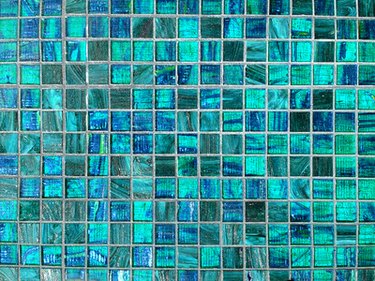Things You'll Need
Dust mask or respirator
Straightedge
Carbide-tipped scoring tool or utility knife
Thinset mortar
Notched trowel (1/2 in. by 1/2 in. )
Five gallon bucket
Hammer drill and 5/32-inch bit
1-1/2-in. #8 flathead tapcon screws
Drill with Phillips bit

HardieBacker brand cement board is a popular substrate for ceramic tile and stone. Cement boards are highly moisture resistant, and bond well with thinset mortar; this makes them the preferred underlayment for shower stalls. HardieBacker is typically fastened to wooden or steel studs, but it can be applied to cinderblock. Cement board can be installed using common hand tools. Get a helper for this project.
Step 1
Cut the HardieBacker to size. Place the straightedge on the cut line, and score it with the scoring tool or utility knife. Bend the cement board at the score line to cut it.
Video of the Day
Step 2
Mix the thinset mortar in the bucket with clean, room-temperature water. Mix the mortar thoroughly until all the powder is moistened, and add water until the mixture is the consistency of toothpaste. Allow the mortar to set, or "slake," for five to 15 minutes, then remix it. There are slight variations between brands of mortar; read the instructions on the bag.
Step 3
Apply the mortar to the cinderblock wall using the notched trowel. Hold the trowel at a 60-degree angle to the wall, and work in a semicircular sweeping motion.
Step 4
Press the HardieBacker board firmly and evenly into the bed of mortar. The surface tension of the mortar is normally enough to hold the HardieBacker in place.
Step 5
Drill holes for the screws using the hammer drill. The exact pattern and spacing of the holes isn't important since the mortar is ultimately what holds the HardieBacker in place. Ten to 15 holes per 3 ft. by 5 ft. sheet will do the job. Keep the holes at least 3/8 in. from each edge and 2 in. from each corner.
Step 6
Drive the tapcon screws into the holes drilled in the previous step. Drive the screws flush with the surface of the HardieBacker board. Allow the mortar to cure overnight before tiling.
Tip
Make sure the cinderblock surface is clean and free of loose material before applying the mortar.
If the cinderblock wall is stable, you may be able to apply tile directly to it with mortar.
Warning
HardieBacker board contains silica compounds. Silica dust will damage the lungs if breathed. Wear a dust mask or respirator when cutting it.
Wear eye and ear protection when using power tools.
Video of the Day